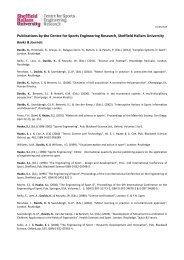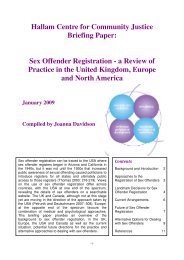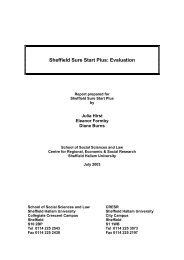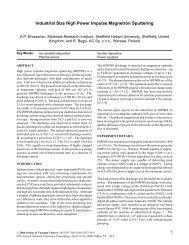The exercise of judicial discretion in rent arrears cases - Sheffield ...
The exercise of judicial discretion in rent arrears cases - Sheffield ...
The exercise of judicial discretion in rent arrears cases - Sheffield ...
Create successful ePaper yourself
Turn your PDF publications into a flip-book with our unique Google optimized e-Paper software.
Hous<strong>in</strong>g benefit<br />
L<strong>in</strong>ked to these general problems which may lead to <strong>arrears</strong>, is the specific issue <strong>of</strong> hous<strong>in</strong>g<br />
benefit. Over 60% <strong>of</strong> tenants <strong>of</strong> social landlords were claim<strong>in</strong>g hous<strong>in</strong>g benefit <strong>in</strong> 2002/03<br />
(ODPM, 2004). A number <strong>of</strong> studies have po<strong>in</strong>ted to the fact that <strong>rent</strong> <strong>arrears</strong> may be<br />
attributable to delays and problems <strong>in</strong> hous<strong>in</strong>g benefit adm<strong>in</strong>istration. In particular delays <strong>in</strong><br />
process<strong>in</strong>g (Pawson et al, 2005, Audit Commission, 2002, Raynsford Dallison, 1992), the<br />
recovery <strong>of</strong> overpayments (follow<strong>in</strong>g a move <strong>in</strong>to work by the tenant) (Pawson et al, 2005,<br />
Evans, 2003), the complexity <strong>of</strong> the hous<strong>in</strong>g benefit system (Pawson et al, 2005, Blandy et al<br />
2002, and Ford and Seavers, 1998), and communication difficulties between the landlord<br />
and the hous<strong>in</strong>g benefit department (Pawson et al, 2005, Blandy et al, 2002, and Ford and<br />
Seavers, 1998) may all contribute to the accumulation <strong>of</strong> <strong>arrears</strong>.<br />
<strong>The</strong> impact <strong>of</strong> hous<strong>in</strong>g benefit (HB) on decisions to move towards possession are clear from<br />
Pawson et al (2005, pp. 67 - 68):<br />
“…the vast majority <strong>of</strong> landlords respond<strong>in</strong>g <strong>in</strong> the postal survey (over 83 per cent <strong>of</strong><br />
LAs [local authorities] and 95 per cent <strong>of</strong> HAs [hous<strong>in</strong>g associations]) reported that<br />
they sometimes issued NSPs where HB claims rema<strong>in</strong>ed outstand<strong>in</strong>g. Similarly, 60<br />
per cent <strong>of</strong> LAs and 79 per cent <strong>of</strong> HAs would, <strong>in</strong> some <strong>cases</strong>, enter a case <strong>in</strong> court<br />
even where there was an unresolved HB application.<br />
Case study evidence shows that the commonest scenario where a Notice will be<br />
served on a tenant await<strong>in</strong>g settlement <strong>of</strong> a Hous<strong>in</strong>g Benefit claim is where it is<br />
considered that the delay results from the tenant’s own failure to provide requested<br />
<strong>in</strong>formation (e.g. identification documents required under the HB verification regime).<br />
By and large, hous<strong>in</strong>g associations appeared more likely than local authorities to<br />
issue Notices where HB claims rema<strong>in</strong>ed outstand<strong>in</strong>g for reasons other than those<br />
described above. In at least two case study HAs there was an explicit policy <strong>of</strong> us<strong>in</strong>g<br />
Notices to pressurise Hous<strong>in</strong>g Benefit Departments to prioritise specific <strong>cases</strong> (<strong>in</strong><br />
breach <strong>of</strong> Hous<strong>in</strong>g Corporation advice (Hous<strong>in</strong>g Corporation, 2004)). It was,<br />
however, appa<strong>rent</strong> that <strong>in</strong> some areas HB <strong>of</strong>ficers rout<strong>in</strong>ely advised HAs to <strong>in</strong>itiate<br />
court action to trigger ‘fast track’ process<strong>in</strong>g <strong>of</strong> <strong>cases</strong>. <strong>The</strong> <strong>rent</strong> <strong>arrears</strong> procedure<br />
manual <strong>of</strong> one case study HA explicitly advised <strong>of</strong>ficers to serve Notices on all<br />
tenants whose <strong>arrears</strong> exceeded a given threshold value, mak<strong>in</strong>g clear that such<br />
action was to be taken irrespective <strong>of</strong> the tenant’s HB status ‘to protect the<br />
association’s <strong>in</strong>terest’. <strong>The</strong> extent to which the tenants affected were made aware<br />
that Notices issued to <strong>in</strong>fluence HB casework prioritisation did not represent any<br />
genu<strong>in</strong>e <strong>in</strong>tention to pursue legal action was not clear.”<br />
<strong>The</strong> impact <strong>of</strong> hous<strong>in</strong>g benefit issues on the decisions <strong>of</strong> district judges is someth<strong>in</strong>g which<br />
we have sought to explore <strong>in</strong> this study and is considered <strong>in</strong> Chapter 7.<br />
13
















